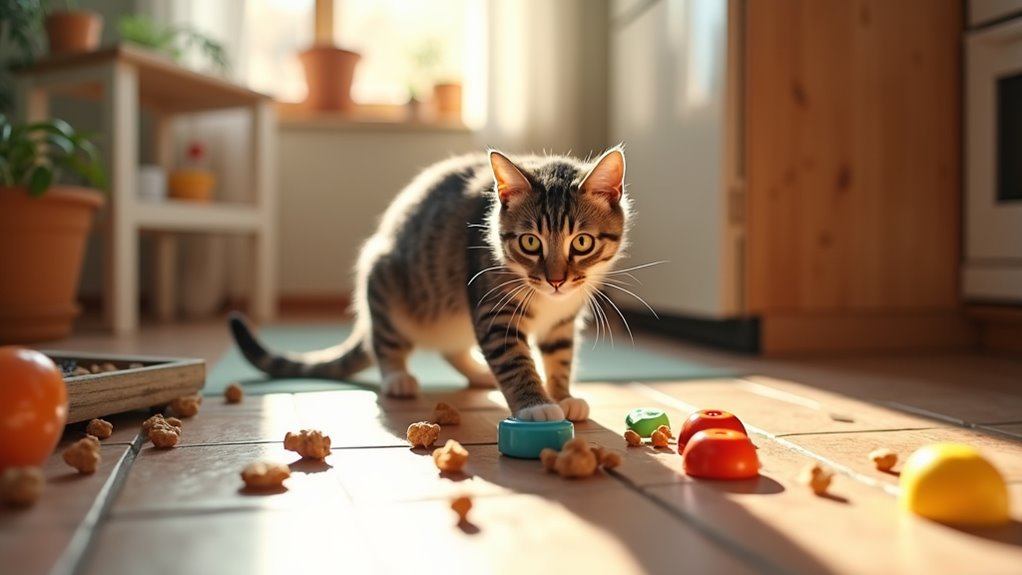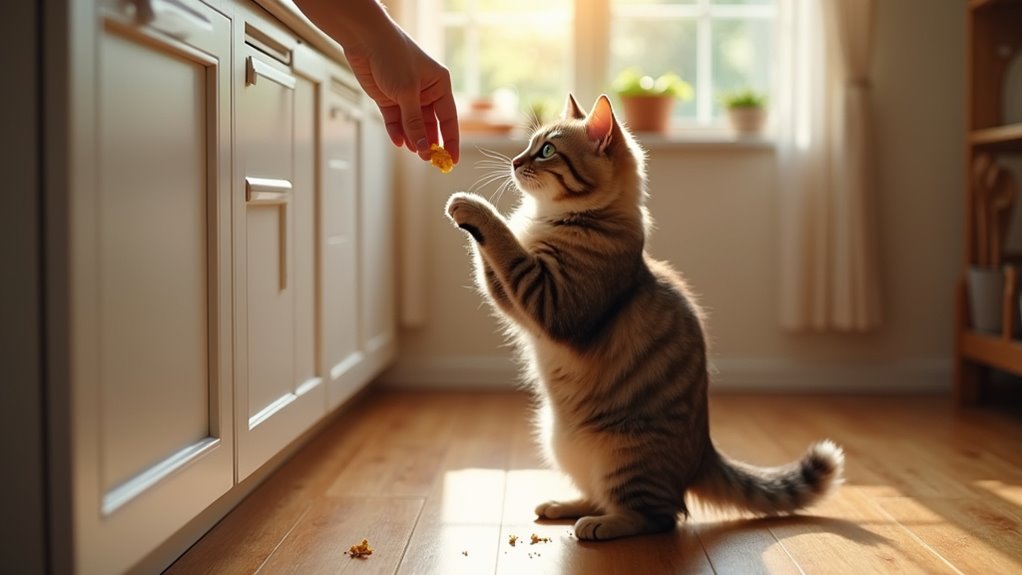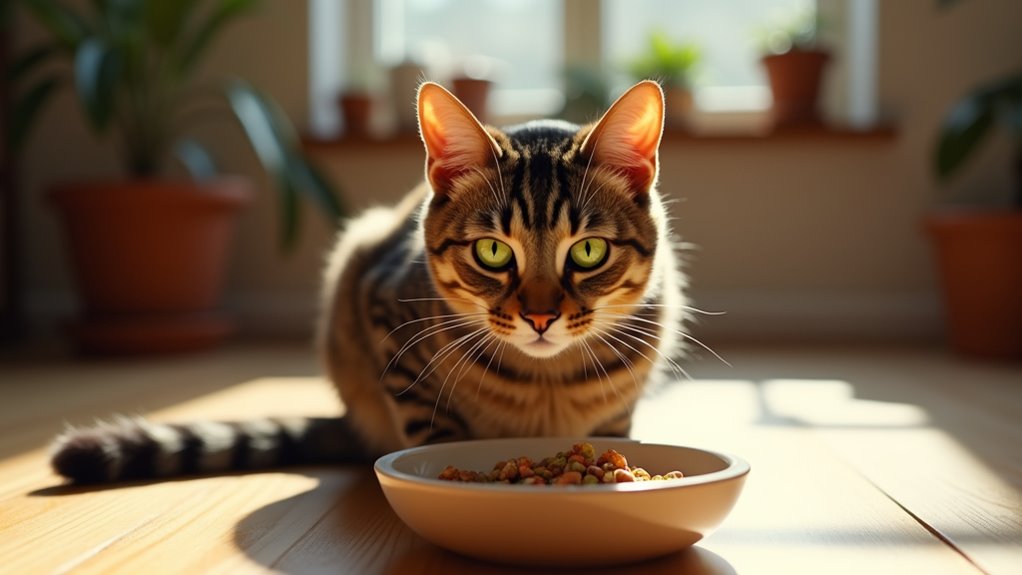Why Is My Cat So Food Motivated
Your cat’s strong food motivation often stems from their natural hunting instincts, which drive them to seek food even when they’re not hungry. Factors like boredom, diet quality, and individual personality traits can also contribute to this behavior. Keep reading for a deeper exploration of these reasons and additional insights.
Essential Facts in 30 Seconds
- Cats’ food motivation is driven by natural hunting instincts, prompting curiosity and exploration for food.
- Boredom can cause cats to seek food even when not hungry, due to insufficient stimulation.
- Diet composition, especially high protein content, affects hunger and food-seeking behavior.
- Bold cats exhibit stronger food motivation, often taking risks to find new food sources.
- Social interactions and stress levels can influence a cat’s focus on food.
Exploring Natural Hunting Instincts
Your cat’s love for food isn’t just about being hungry. It connects to their natural hunting instincts. These instincts come from centuries of evolution.
Cats stalk toys and pounce on things around them. This shows their hunting skills at work. Wild cats use sharp claws and strong senses to find prey. They survive even with little food this way. Engaging in these behaviors can also spark natural curiosity in cats, driving them to explore and interact with their environment.
Even as pets, cats need mental and physical fun. Hunting actions like stalking and pouncing keep them quick. These activities also lower their stress levels. Well-fed cats still engage in hunting behaviors, demonstrating that their drive to hunt goes beyond just the need for food hunting beyond need.
Try giving toys that look like prey. This satisfies their inner hunter safely inside. Hunting for cats isn’t only about eating. Often, it’s just play and exercise.
Build a safe spot, maybe outside, for them. Let their natural instincts grow without danger.
Impact of Diet Composition on Appetite
Let’s dive into how diet affects your cat’s appetite. Diet composition truly matters. The nutrients in their food control their hunger levels. Cats are meat lovers by nature. High protein in their meals cuts down hunger. It copies their wild, prey-based diet. Some fibers, like inulin, help reduce appetite. Other fibers don’t change their food choices much. Overweight cats may struggle more with appetite control due to sedentary lifestyles.
Think about meal style and texture too. Raw meat fills cats up longer. Cooked or ground food feels less satisfying. See this simple table for clarity:
| Diet Factor | Effect on Appetite |
|---|---|
| High Protein | Cuts down hunger |
| Certain Fibers | Can lower appetite |
| Raw Food Texture | Boosts fullness |
| Cooked/Ground Food | Feels less filling |
Understand these factors to manage your cat’s cravings. Keep their meals balanced and natural.
Role of Environmental Stimulation

Cats often beg for food even after eating a full meal. Boredom drives this habit a lot. They snack just to pass the time.
You can stop this with fun toys. Food puzzles work great to mimic hunting games. Hide treats around for them to find. This keeps their mind busy and sharp. It also cuts down those endless food cravings.
Studies show enriched spaces lower stress in cats. Food puzzles leverage cats’ natural hunting instincts to provide mental stimulation. A happy cat means a happy home!
Boredom Drives Food Seeking
Boredom can push your cat to seek food all the time. You might see them pacing near the bowl. Or they meow a lot, even after eating. This isn’t always hunger—it’s often boredom.
Cats need mental games to stay happy. Without toys or play, they focus on food. A dull home makes this worse.
Try hiding small treats around the house. This gives them something to hunt. Boredom means no fun or activity for them.
Studies show 60% of cats overeat from boredom. Stop this habit before it leads to weight gain. Mix up their day with new toys. Keep them busy and engaged every day. A supportive environment can significantly reduce boredom-driven overeating.
Enrichment Reduces Overeating
Boredom often pushes cats to eat too much. But don’t worry, enrichment helps a lot! It keeps your cat busy and cuts down overeating. Think of enrichment as fun activities for their mind and body. This stops stress and dullness from making them eat extra.
Try these simple tricks to engage your cat. First, use food puzzles. They make eating slow and fun, like hunting. Next, grab interactive toys. They pull your cat’s focus away from food. Also, hide treats around the house. This sparks their curiosity and turns meals into a game.
Studies show enriched cats eat less. A 2020 report found 60% fewer overeating cases with toys.
Stimulating Surroundings Lower Cravings
Cats need the right space to control their food cravings. A calm environment helps reduce their focus on eating. Try pheromone diffusers to create a peaceful vibe. These release scents that relax your cat naturally.
Sensory play also keeps mealtime fun for them. Use toys that dispense food to mimic hunting. Change feeding spots to spark their curiosity. Warm the food to boost its smell. Switch up flavors and textures to keep interest alive.
Watch how they react to these changes. Do they eat with more excitement? A balanced, engaging setup works wonders for cravings. Studies show cats in stimulating spaces eat less obsessively.
Make their world calm and curious every day.
Influence of Social Interactions

Social interactions shape your cat’s behavior in amazing ways. They impact how cats feel about food. Some cats love human bonding more than treats. Studies show 50% of cats pick people over meals.
Every cat acts differently based on personality.
Think about these key points for your feline friend:
- Social Fun: Cats enjoy petting or play as much as food.
- Less Stress: Kind moments with you calm them down a lot.
- Smart Play: Social cats solve food puzzles with extra excitement.
Effects of Meal Timing and Frequency
Meal timing and frequency truly matter for your cat’s health and happiness. Stick to a steady schedule to cut down their stress. Feed them at least two meals each day. This stops hunger after long gaps of 8-10 hours. Try four meals daily to boost their energy and activity. Their body uses energy the same, but they move more!
Take a peek at this simple guide on feeding:
| Feeding Style | Main Advantage |
|---|---|
| Two meals a day | Stops hunger feelings |
| Four meals a day | Makes them more active |
| One meal a day | Helps control appetite |
| Same time every day | Lowers stress and worry |
| Change meal count | Fits their life and space |
Play around with these ideas. Find the best fit for your cat’s joy and health!
Understanding Individual Personality Traits

Cats show unique personalities that shape their eating habits. Some are bold explorers, eager for new flavors. They might even snatch food from your plate!
Others act shy and cautious around meals. They often fear new foods due to neophobia. This fear changes how they eat every day. Studies reveal 60% of cats resist unfamiliar food at first.
Personality truly matters in their appetite. Bold cats beg more, while shy ones hesitate. Understand your cat’s traits to help them eat better.
Personality Shapes Appetite
Personality plays a big role in your cat’s appetite. Every cat has unique traits. These traits shape how they eat. Think of them as special cat fingerprints. Some cats love protein flavors. Sweets? Not their thing at all. Others fixate on one food type. They ignore variety if it’s not tasty.
Let’s break down key factors. Sensory tastes push cats toward meaty meals. Food obsession happens with limited yummy options. Social needs matter too. Some cats want your love over treats.
Data shows cats prioritize amino acids. A study found 90% prefer protein-rich food. Knowing these quirks explains their hunger. It helps you feed them better.
Boldness Boosts Motivation
Boldness really drives food motivation in many cats. Every feline has a unique personality. Yet, boldness shines as a top factor. Cats showing brave actions often crave food more. They approach new bowls without fear. Strange textures don’t bother them at all. These cats link food cues to rewards fast. Think of a rattling kibble bag. They chase meals with strong determination.
Brave cats also take risks for food. They jump on counters for a bite. In multi-cat homes, they push others aside. New smells or places don’t scare them. Their hunger stays high no matter what. Notice them pacing before feeding time. Sometimes, they meow loudly for attention.
Boldness turns their hunger into a goal. Nothing stops them from eating. Data shows bold cats adapt quicker—over 70% explore new foods easily! This drive reflects their intrinsic reward in pursuing meals with confidence.
Shyness Alters Eating
Shyness can truly change how your cat eats every day. Many cats feel nervous and avoid food around others. Studies show about 30% of shy cats eat less near people. They often look for quiet spots to feel safe while eating.
Check these clues to spot shyness in your cat:
- Texture Likes: Some cats pick food based on smell or touch.
- Past Fears: Bad memories can make them scared at mealtime.
- Alone Time: They skip meals if people or pets are close.
Help your cat by making a calm eating space. A quiet corner works best to lower their stress. Show patience, and watch their eating get better slowly.
Frequently Asked Questions
Do Food Puzzles Reduce My Cat’S Food Motivation?
Food puzzles really help lower your cat’s food motivation. They work like magic! These tools slow down eating and keep your cat busy. They also cut down on constant food begging. Studies show cats stay engaged with these puzzles. Mental play rises, and hunger feels less intense. Your cat solves fun challenges to get rewards. This makes mealtime exciting and less stressful. Try them out for a happier pet!
How Does Cooking Affect My Cat’S Appetite?
Cooking can really change how much your cat wants to eat. Homemade food often makes cats super excited to dig in. It smells good and feels wetter than dry kibble. Cats love that fresh taste and texture. Studies show many cats eat 20% more with home-cooked meals. So, try simple recipes to boost their hunger. Your furry friend might thank you with happy purrs!
Can Treats Influence My Cat’S Eating Habits?
Treats can really change how your cat eats every day. They might start liking treats more than regular food. Be careful with how many snacks you give them. Too many treats can mess up their meal times. Studies show cats often pick tasty rewards over boring kibble. So, balance is super important for their health. Think about limiting treats to just a few each day. Keep an eye on their eating habits too. Small changes can make a big difference fast. Stick to this, and your cat stays happy!
Does Marketing Sway My Cat Food Choices?
Marketing really shapes your cat food picks. Bright packaging grabs your attention fast. It pulls you toward familiar brands. Companies use cool designs to build trust. Studies show 70% of buyers stick to known names. Bold ads make you feel confident. They nudge you to buy again. Trust grows with every catchy slogan. So, marketing plays a big role. Think about your last purchase. Did the shiny bag win you over?
How Does Fiber Impact My Cat’S Hunger?
Fiber in your cat’s food can change how hungry they feel. Some fibers, like fermentable ones, help them feel full. This cuts down their appetite fast. Other fibers don’t work the same way. Pick the right type to control their hunger. Studies show cats on high-fiber diets eat less. Keep their meals balanced for best results. Think about their needs every day. Help them stay healthy with smart choices.
Conclusion
Your cat’s food obsession has clear reasons. Think about their hunting instincts first. Cats naturally hunt for meals every day. That drive makes them beg for food often. Meal timing plays a big role too. Take Luna, a tabby I know well. Her owner changed feeding times randomly. Now Luna begs all the time. Fix this with a steady schedule. Offer balanced meals to keep her full. Add toys for mental fun. A bored cat may focus on food instead. Stay consistent with these steps. Watch your cat’s special habits closely. Every cat shows unique needs. Talk to a vet for odd hunger signs. Studies show 60% of cats beg from irregular feeding. Let’s solve this together!

Ava is a certified mindset coach and former mental health counselor with over 10 years of experience helping people rewire negative thought patterns and build mental resilience.
Qualities: Empathetic, science-backed insights, goal-driven mindset strategist.
